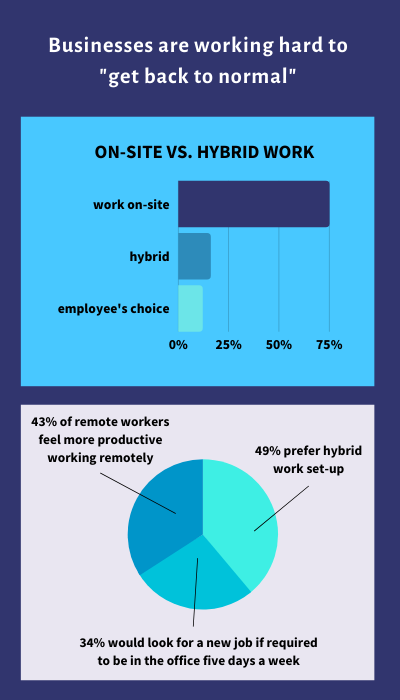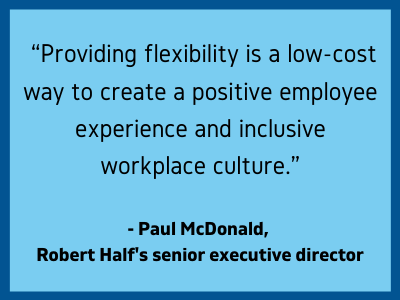On-site, fully remote, or hybrid? 3 things you must consider before deciding.

The pandemic has given employers a lot to think about. With vaccinations rolling out, businesses are working hard to “get back to normal” or in many cases determine what normal looks like now. While many companies may be ready to move quickly back to a fully on-site workforce, and others are exploring hybrid or fully remote options, employees have their own expectations and are willing to look for a new position if they aren’t met.
While adapting and determining the right setup for your organization can be challenging, one positive is that you’re not alone in doing so. Many businesses are facing the same challenges, and in there we can find some shared wisdom. Let’s take a look at some key issues around remote work and how businesses are handling them.
Looming post-pandemic battle: On-site vs. hybrid work
Almost three-fourths of U.S. employers plan to require employees to work on-site once covid-19-related restrictions completely lift, according to a new survey by the Robert Half staffing firm. Far fewer—16%—will allow employees to follow a hybrid schedule, where they can divide time between the office and another location. Only 12% plan to give staff the complete freedom to choose where they work.
Previous research found that 49% of employees prefer a hybrid arrangement, and 34% of professionals currently working from home due to the pandemic would look for a new job if required to be in the office five days a week. In a separate survey, 43% of workers said they feel much more productive when working remotely than in the office.
That argues for at least exploring the feasibility of implementing a hybrid work option. “Providing flexibility is a low-cost way to create a positive employee experience and inclusive workplace culture,” said Paul McDonald, Robert Half’s senior executive director.
Survey participants identified these challenges of managing hybrid teams:
- Communicating effectively with team members
- Trusting employees to get work done
- Gauging workloads and helping staff avoid burnout
- Effectively recognizing and rewarding employee accomplishments
- Finding time for team development.
The added complexity of a remote workforce has more employers moving to HRIS systems
Your HR duties have grown more complex in recent years, and the spike in remote employees is only adding to that stress. That’s why more HR departments of all sizes are turning to human resource information system (HRIS) software to streamline their growing list of tasks.
HRIS systems have evolved rapidly in the past decade, developing into an all-encompassing workforce tool. They aim to seamlessly manage your backend people-related admin tasks.
Most HRIS systems deal with tracking time and labor management (including PTO and attendance), payroll/taxes, benefits administration (and selections), employee demographic information, applicant tracking, onboarding, performance management, and more.
The great benefit of having a central repository for all these employee tasks is that everything is automated, in one place and just a few clicks away. HRIS tools can also help with HR compliance and deliver a faster and easier user experience for employees.
All of this comes at a price. But newer cloud-based systems aimed at smaller businesses allow organizations to pay by employee (or contractor) with no setup fees. Typical prices range anywhere from $1 to $15 per month per employee, depending on the features offered. Bigger enterprise systems may cost larger companies thousands or even millions to implement. One key point: Make sure any HRIS contract specifies the amount of training and support you’ll get.
Top-rated HRIS solutions
 Dozens of capable HRIS tools are on the market. Using user reviews from hundreds of HR professionals, two independent software research firms (G2 and Software Advice) have cited these as some of the best HRIS products in 2021 (listed in alpha order):
Dozens of capable HRIS tools are on the market. Using user reviews from hundreds of HR professionals, two independent software research firms (G2 and Software Advice) have cited these as some of the best HRIS products in 2021 (listed in alpha order):
- ADP Workforce Now. This all-in-one, cloud-based platform bundles the typical HR processes, including payroll, benefits admin, compliance and talent management. A self-service mobile app lets employees enroll in benefits and access timesheets, W-2 forms and other payroll data.
- BambooHR. This cloud-based tool is designed for small and midsized businesses and includes benefits, payroll, an applicant tracking system (ATS) and various employee engagement tools. Lots of customization is available to users, including role-based access to build custom user groups.
- Paycom. This built-out HR solution offers all the typical HR functions, plus a mobile app that’s easy to navigate. Support options are not as robust as some other competitors.
- Paycor. Another cloud-based suite for small and midsized companies, Paycor offers basic HRIS features, plus tools like a learning management system that provides virtual or classroom training. Its analytics platform lets you create data visuals to show HR, payroll and time trends in one report.
- Workday HCM. The Human Capital Management tool is a cloud-based system that aims to evolve with the needs of the organization. It offers a solid list of features and includes a user-friendly interface.
- Zenefits. Another cloud-based platform aimed at smaller and midsized companies, Zenefits offers all the typical core HR functions, plus features like an employee wellness program. An extra service lets you tap into a team of HR and payroll experts for questions.
Pay some teleworkers less based on location?
Your employees’ expenses vary greatly depending on where they are located. Living in New York City or San Francisco costs much more than it does in rural Texas or small-town Maine. Perhaps your pay grades should reflect that difference.
When the coronavirus pandemic hit, millions of workers were sent home to telework—wherever they decided to call home. Some stayed close to their former offices, while others decamped to second homes or returned to their childhood hometowns. Some took the opportunity to effectively give themselves substantial raises by moving from expensive locations to low cost-of-living areas while still banking big-city salaries.
It may be time to rethink how much you pay remote employees. Some large employers already have.
For example, Google recently told teleworkers they could continue working from home, but no, they should not expect to be paid the same if the work’s being done from a lower-cost area. A widely circulated internal salary calculator showed that an employee telecommuting from Connecticut can now expect to be paid 15% less than someone doing the same job from a home office in New York City.
If you are considering adjusting your compensation strategy for remote employees, expect backlash. Two tactics will make it easier to weather the criticism:
1. First, develop a formal telework policy. Many employers never documented their policies and procedures in 2020 when covid triggered a sudden exodus from the office. Now is the time.
2. Decide whether you will base pay on the location where remote employees do their work, the location of your nearest facility, or some other criteria. Announce your new pay schedule and terms.
One caution: If disabled workers are telecommuting as a reasonable accommodation, check with your attorney before lowering their pay. It could trigger ADA complaints.
Advice: Do you really know where your remote workers are based? Include a rule in your telework policy requiring employees to honestly report where they are working.




